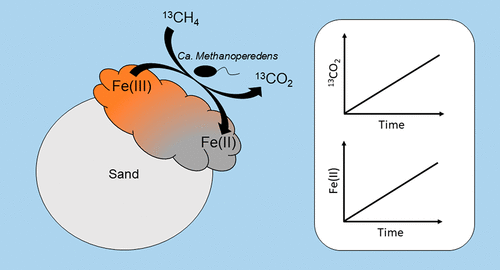当前位置:
X-MOL 学术
›
Environ. Sci. Technol. Lett.
›
论文详情
Our official English website, www.x-mol.net, welcomes your
feedback! (Note: you will need to create a separate account there.)
Isotopic Labeling Reveals Microbial Methane Oxidation Coupled to Fe(III) Mineral Reduction in Sediments from an As-Contaminated Aquifer
Environmental Science & Technology Letters ( IF 8.9 ) Pub Date : 2021-07-29 , DOI: 10.1021/acs.estlett.1c00553 Aleksandra Pienkowska 1 , Martyna Glodowska 1, 2, 3 , Muammar Mansor 1 , Daniel Buchner 4 , Daniel Straub 2, 5 , Sara Kleindienst 2 , Andreas Kappler 1
Environmental Science & Technology Letters ( IF 8.9 ) Pub Date : 2021-07-29 , DOI: 10.1021/acs.estlett.1c00553 Aleksandra Pienkowska 1 , Martyna Glodowska 1, 2, 3 , Muammar Mansor 1 , Daniel Buchner 4 , Daniel Straub 2, 5 , Sara Kleindienst 2 , Andreas Kappler 1
Affiliation

|
Although arsenic (As) groundwater contamination in South and Southeast Asia is a threat to human health, mechanisms of its release from sediment to groundwater are still not fully understood. In many aquifers, Fe(III) minerals are often the main hosting phases for As and their stability is crucial for As mobility. Recently, a new mechanism for As mobilization into groundwater was proposed with methane (CH4) serving as an electron donor for microbially mediated reductive dissolution of As-bearing Fe(III) minerals. To provide unequivocal evidence for the occurrence of Fe(III)-coupled methanotrophy, we incubated sediments from an As-contaminated aquifer in Hanoi (Vietnam) anoxically with isotopically labeled 13CH4. Up to 35% of the available Fe(III) was reduced within 232 days with simultaneous production of 13CO2 demonstrating anaerobic oxidation of 13CH4 with Fe(III) as the electron acceptor. The microbial community at the end of the incubation was dominated by archaea affiliating with Candidatus Methanoperedens, implying its involvement in Fe(III)-dependent CH4 oxidation. These results suggest that methanotrophs can contribute to dissolution of As-bearing Fe(III) minerals, which eventually leads to As-release into groundwater.
中文翻译:

同位素标记揭示了微生物甲烷氧化与来自污染含水层的沉积物中的 Fe(III) 矿物还原相结合
尽管南亚和东南亚的砷 (As) 地下水污染对人类健康构成威胁,但其从沉积物释放到地下水的机制仍未完全了解。在许多含水层中,Fe(III) 矿物通常是 As 的主要承载相,它们的稳定性对 As 的流动性至关重要。最近,提出了一种将砷迁移到地下水中的新机制,其中甲烷 (CH 4 ) 作为电子供体用于微生物介导的含砷 Fe(III) 矿物的还原溶解。为了为 Fe(III) 耦合甲烷营养的发生提供明确的证据,我们用同位素标记的13 CH 4对河内(越南)受砷污染的含水层中的沉积物进行缺氧培养. 在 232 天内减少了高达 35% 的可用 Fe(III),同时产生13 CO 2表明13 CH 4以 Fe(III) 作为电子受体进行厌氧氧化。在温育结束时,微生物群落由古细菌用联盟关系为主暂定Methanoperedens,这意味着其在铁(III)的参与依赖性CH 4氧化。这些结果表明甲烷氧化菌可以促进含砷的 Fe(III) 矿物的溶解,最终导致砷释放到地下水中。
更新日期:2021-09-14
中文翻译:

同位素标记揭示了微生物甲烷氧化与来自污染含水层的沉积物中的 Fe(III) 矿物还原相结合
尽管南亚和东南亚的砷 (As) 地下水污染对人类健康构成威胁,但其从沉积物释放到地下水的机制仍未完全了解。在许多含水层中,Fe(III) 矿物通常是 As 的主要承载相,它们的稳定性对 As 的流动性至关重要。最近,提出了一种将砷迁移到地下水中的新机制,其中甲烷 (CH 4 ) 作为电子供体用于微生物介导的含砷 Fe(III) 矿物的还原溶解。为了为 Fe(III) 耦合甲烷营养的发生提供明确的证据,我们用同位素标记的13 CH 4对河内(越南)受砷污染的含水层中的沉积物进行缺氧培养. 在 232 天内减少了高达 35% 的可用 Fe(III),同时产生13 CO 2表明13 CH 4以 Fe(III) 作为电子受体进行厌氧氧化。在温育结束时,微生物群落由古细菌用联盟关系为主暂定Methanoperedens,这意味着其在铁(III)的参与依赖性CH 4氧化。这些结果表明甲烷氧化菌可以促进含砷的 Fe(III) 矿物的溶解,最终导致砷释放到地下水中。









































 京公网安备 11010802027423号
京公网安备 11010802027423号